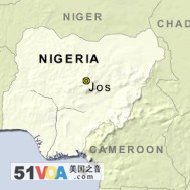Kano, Nigeria
31 March 2009
The farming of cowpea in Niger is being hindered by a lack of arable land, poor crop varieties and outdated farming methods. About 80 percent of Niger's people there are subsistence farmers and herders who use fallow farming techniques to grow cowpea. In this system, the land remains unplanted for a period of time so nutrients needed for healthy plants can regenerate in the soil. The system does not allow for the rapid growth of crops.
Farmers also plant cowpea among crops with leaves that provide too much shade and thus impede its growth. The older cowpea varieties are also susceptible to a parasitic plant called striga, which competes with the food crop for moisture and nutrients.

He discusses another challenge faced by farmers.
Fertilizer," he explains, "is not available in the quantity required in Nigeria, Niger or anywhere in Africa. But we need fertilizer, so we are now teaching [farmers] them how to use their livestock to generate manure."
But the new project by the IITA and the Ministry of Agriculture is working to turn the situation around.
IITA scientists are introducing better yielding strains of cowpea that take 65 to 70 days to mature ?nearly half the time of old varieties. They are also resistant to striga.
Also, he says farmers are taught how to enhance regular commercial fertilizers. The animals eat crop residue for 60 to 70 days and generate manure that will be used to provide nutrients to the soil.
The farmer digs a hole about 10 cm from the plant and puts a small amount of manure in it.This method, called spot application, reduces the amount of chemical fertilizers needed.
Dr. Hakeem says the IITA livestock project includes improved farming methods.
"We have brought a new system, he explains, "the strip cropping system, whereby the farmers can plant either one or two rows of cereals: four rows of cowpea. This creates a window for cowpea because with these four shading is minimized."
Dr. Addam Kiri Saidon is a soil scientist at an institution also involved in the effort, the National Institute of Agronomic Research of Niger (INRAN).
He says Peace Corps volunteers from the United States will help train farmers in the regions of Maradi and Zinder in the new farming techniques and application of the new seed varieties.
The collaboration," he explains,"is more on the transfer of technology, working hand in hand with the eace orps volunteers. They serve as a link between the project and farmers in the villages and IITA is helping with funds, new technologies, even also in some aspects of research."
Niger produces nearly 700,000 tons of cowpea each year, making it the world's second largest producer, after Nigeria. It's the country's main agricultural export.
It is also an indispensable part of the family diet, eaten as bean cakes and bean pudding. As West Africa's population grows, so does the demand for improved crops of the well-loved cowpea.
|
|
|
We'd like to hear what you have to say. Let us know what you think of
this report and other news and features on our website. Email your views
about what is happening in Africa to: africa@voanews.com. Please
include your name and phone number if you would like us to include your
comments on our programs. Or, telephone us and leave a message. In the US, call: (202) 205-9942.
After you hear the VOA greeting, press the number "30" and leave your opinion. We
may use it on our daily broadcasts. |